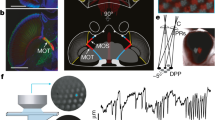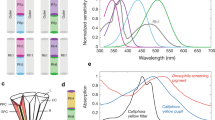Summary
We propose that inDrosophila melanogaster the optomotor response to both horizontal and vertical movement is mediated predominantly by the 6 large retinula cells (R1–6) in each facet of the compound eye. Evidence is presented which indicates that this may also be true for most of the other visual responses which at present can be quantitatively studied. These responses include visually controlled landing, pattern-induced orientation of flying and walking animals, the abnormal jump reflex of the mutant Hk1 (Kaplan, 1976) and probably also phototaxis. The only function for which the small retinula cells R7 and/or R8 seem to be required so far is spectral wavelength discrimination in phototaxis at high light intensity. Our hypothesis is based on studies of the receptor deficient mutantssevenless, outer rhabdomeres absent andreceptor degeneration B as well as on results of bleaching experiments by which the retinula cells R1–6 of the eye color mutantwhite can be reversibly blocked.
Visual performance of wild typeDrosophila in the optomotor response reflects receptor properties (visual acuity, spectral sensitivity and polarization sensitivity) expected for the R1–6 receptor subsystem. The notion of a ‘high sensitivity’ and a ‘high acuity’ state which was proposed earlier on the basis of experiments on various visual mutants is in agreement with the present results but their interpretation as reflecting properties of different receptor subsystems must be abandoned. Experimental data on wild type also suggest the existence of such an adaptational mechanism; this, however, remains to be demonstrated more conclusively.
Similar content being viewed by others
References
Arnett, D.W.: Spatial and temporal integration properties of units in first optic ganglion of Dipterans. J. Neurophysiol.35, 429–444 (1972)
Bertholf, L.M.: The extent of the spectrum forDrosophila and the distribution of stimulative efficiency in it. Z. vergl. Physiol.18, 32–64 (1933)
Braitenberg, V., Hauser-Holschuh, H.: Patterns of projection in the visual system of the fly. II. Quantitative aspects of second order neurons in relation to models of movement perception. Exp. Brain Res.16, 184–209 (1972)
Buchner, E.: Elementary movement detectors in an insect visual system. Biol. Cybernetics24, 85–101 (1976)
Cosens, D.J., Briscoe, D.: A switch phenomenon in the compound eye of the white-eyed mutant ofDrosophila melanogaster. J. Insect Physiol.18, 627–632 (1972)
Eckert, H.: Die spektrale Empfindlichkeit des Komplexauges vonMusca. Kybernetik9, 145–156 (1971)
Eckert, H.: Optomotorische Untersuchungen am visuellen System der StubenfliegeMusca domestica L. Kybernetik14, 1–23 (1973)
Franceschini, N.: Sampling of the visual environment by the compound eye of the fly: fundamentals and applications. In: Photoreceptor optics (eds. A.W. Snyder, R. Menzel), pp. 98–125. Berlin-Heidelberg-New York: Springer 1975
Franceschini, N., Kirschfeld, K.: Etude optique in vivo des éléments photorécepteurs dans l'oeil composé deDrosophila. Kybernetik8, 1–13 (1971)
Götz, K.G.: Optomotorische Untersuchungen des visuellen Systems einiger Augenmutanten der FruchtfliegeDrosophila. Kybernetik2, 77–92 (1964)
Götz, K.G.: Flight control inDrosophila by visual perception of motion. Kybernetik4, 199–208 (1968)
Harris, W.A., Stark, W.S., Walker, J.A.: Genetic dissection of the photoreceptor system in the compound eye ofDrosophila melanogaster. J. Physiol. (Lond.)256, 415–439 (1976)
Hauser-Holschuh, H.: Vergleichende quantitative Untersuchungen an den Sehganglien der FliegenMusca domestica undDrosophila melanogaster. Doctoral Thesis, Eberhard-Karls-Universität, Tübingen (1975)
Heisenberg, M.: Comparative behavioral studies on two visual mutants ofDrosophila. J. comp. Physiol.80, 119–136 (1972)
Heisenberg, M., Götz, K.G.: The use of mutations for the partial degradation of vision inDrosophila melanogaster. J. comp. Physiol.98, 217–241 (1975)
Hotta, Y., Benzer, S.: Genetic dissection of theDrosophila nervous system by means of mosaics. Proc. nat. Acad. Sci. (Wash.)67, 1156–1163 (1970)
Kaiser, W.: The relationship between visual movement detection and colour vision in insects. In: The compound eye and vision of insects. (G.A. Horridge, ed.), pp. 359–377. Oxford: Clarendon Press 1974
Kaplan, W.D.: The use of double mutants in the investigation of visual mutants ofDrosophila (Abstract). Genetics83, s38-s39 (1976)
Kaplan, W.D., Trout, W.E.: The behaviour of four neurological mutants ofDrosophila. Genetics61, 399–409 (1969)
Kirschfeld, K.: Absorption properties of photopigments in single rods, cones and rhabdomeres. In: Processing of optical data by organisms and machines. New-York-London: Academic Press 1969
Kirschfeld, K.: Aufnahme und Verarbeitung optischer Daten im Komplexauge von Insekten. Naturwissenschaften58, 201–209 (1971)
Kirschfeld, K.: The visual system ofMusca: Studies on optics, structure and function. In: Information processing in the visual system of arthropods (R. Wehner, ed.), pp. 61–74. Berlin-Heidelberg-New York: Springer 1972
Kirschfeld, K., Franceschini, N.: Optische Eigenschaften der Ommatidien im Komplexauge vonMusca. Kybernetik5, 47–52 (1968)
Kirschfeld, K., Lutz, B.: Lateral inhibition in the compound eye of the flyMusca. Z. Naturforsch.29c, 95–97 (1974)
Kirschfeld, K., Reichardt, W.: Optomotorische Versuche anMusca mit linear polarisiertem Licht. Z. Naturforsch.25b, 228 (1970)
Kirschfeld, K., Snyder, W.: Waveguide mode effects, birefringence and dichroism in fly photoreceptors. In: Photoreceptor optics (eds. A.W. Snyder, R. Menzel), pp. 56–77. Berlin-Heidelberg-New York: Springer 1975
McCann, G.D., Arnett, D.W.: Spectral and polarization sensitivity of the dipteran visual system. J. gen. Physiol.59, 534–558 (1972)
McCann, G.D., MacGinitie, G.F.: Optomotor response studies of insect vision. Proc. roy. Soc. B163, 369–401 (1965)
Menne, D., Spatz, H.C.: Color vision inDrosophila melanogaster. J. comp. Physiol.114, 301–312 (1977)
Menzel, R.: Colour receptors in insects. In: The compound eye and vision of insects. (ed. G.A. Horridge), pp. 121–178. Oxford: Clarendon Press 1975
Mimura, K.: Some spatial properties in the first optic ganglion of the fly. J. comp. Physiol.105, 65–82 (1976)
Minke, B., Wu, C.F., Pak, W.L.: Isolation of light-induced response of the central retinula cells from the electroretinogram ofDrosophila. J. comp. Physiol.98, 345–355 (1975)
Pak, W.L., Pinto, L.H.: Genetic approach to the study of the nervous system. Ann. Rev. Biophys. Bioengin.5, (1976)
Pask, C., Snyder, A.W.: Angular sensitivity of lens-photoreceptor systems. In: Photoreceptor optics (eds. A.W. Snyder, R. Menzel), pp. 159–166. Berlin-Heidelberg-New York: Springer 1975
Pick, B.: Visual flicker induces orientation behavior in the flyMusca. Z. Naturforsch.29c, 310–312 (1974)
Poggio, T., Reichardt, W.: Considerations on models of movement detection. Kybernetik13, 223–227 (1973)
Poggio, T., Reichardt, W.: Visual control of orientation behavior of the fly. II. Towards the underlying neural interactions. Quart. Rev. Biophys.9 (3), 377–438 (1976)
Reichardt, W., Poggio, T.: Visual control of orientation behaviour of the fly. I. A quantitative analysis. Quart. Rev. Biophys.9 (3), 311–375 (1976)
Scholes, J.: The electrical responses of the retinal receptors and the lamina in the visual system of the flyMusca. Kybernetik6, 149–162 (1969)
Schümperli, R.A.: Evidence for colour vision inDrosophila melanogaster through spontaneous phototactic choice behaviour. J. comp. Physiol.86, 77–94 (1973)
Snyder, A.W., Pask, C.: Spectral sensitivity of Dipteran retinula cells. J. comp. Physiol.84, 59–76 (1973)
Stark, W.S.: Spectral selectivity of visual response alterations mediated by interconversions of native and intermediate photopigments inDrosophila. J. comp. Physiol.96, 343–356 (1975)
Strausfeld, N., Campos-Ortega, J.: Some interrelationships between the first and second synaptic regions of the fly's (Musca domestica) visual system. In: Information processing in the visual system of arthropods (ed. R. Wehner), pp. 23–30. Berlin-Heidelberg-New York: Springer 1972
Taddei-Ferretti, C., Fernandez Perez de Talens, A.: Landing reaction ofMusca domestica. Z. Naturforsch.28, 568–592 (1973)
Uhland, L.: Die Kapelle. In: Gedichte. 1. Edition. Tübingen-Stuttgart; Cotta 1815
Wehrhahn, C.: Evidence for the role of retinal receptors R7/8 in the orientation behaviour of the fly. Biol. Cybernetics21, 213–220 (1976)
Zettler, F., Järvilehto, M.: Lateral inhibition in an insect eye. Z. vergl. Physiol.76, 233–244 (1972)
Author information
Authors and Affiliations
Additional information
The excellent technical help of C. Straub and R. Wolf is gratefully acknowledged. We are most indebted to K.G. Götz who provided the material and spiritual background for this work. We also wish to thank J. Koenig and S. Benzer for contributing the receptor mutants, W.D. Kaplan and Valentin Braitenberg for providing unpublished material. K. Kirschfeld and W.A. Harris supported this work in numerous productive discussions. We are finally obliged to B. Boschek for correcting our English and to Mrs. K. Schulze and Miss C. Hanser for typing the manuscript.
This work was in part supported by a grant of the Deutsche Forschungsgemeinschaft to M.H.
Rights and permissions
About this article
Cite this article
Heisenberg, M., Buchner, E. The rôle of retinula cell types in visual behavior ofDrosophila melanogaster . J. Comp. Physiol. 117, 127–162 (1977). https://doi.org/10.1007/BF00612784
Received:
Issue Date:
DOI: https://doi.org/10.1007/BF00612784




